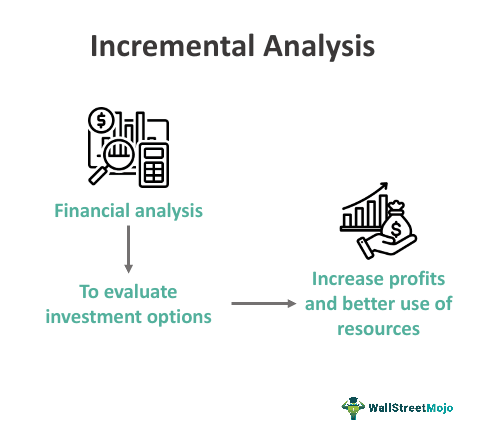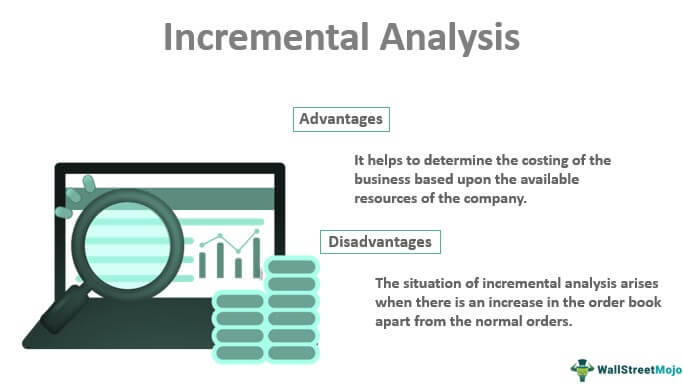Table Of Contents
What Is Incremental Analysis?
Incremental Analysis is referred to the financial analysis undertaken by the company to evaluate the available options, with the objective of improving the profitability by optimizing the capacity utilization and workforce of the business.

In most cases, companies utilise incremental analysis to choose between bulk orders and new business opportunities. The additional business opportunities are received on account of lower than the normal selling price of the company’s product. As the orders are received in bulk, so the purchaser would claim for a lower rate.
Incremental Analysis Explained
The incremental analysis is a method of taking decisions. It is often used by the management to evaluate the best possible option or alternatives of investments. Through this method, the difference between the cost of various approaches are determined.
In this process of incremental capacity analysis, the main aim is to assess the financial implication of adopting different methods of investments, how profitable they may be and their impact on the business in future. This is done through comparison of cost and revenue. It helps the business solve various problems and in the process the information available related to accounting is used. Thus, in this method, the potential result of each alternative is evaluated.
It is often used in various areas of business operation like new product launches, upgradation of the existing software system, adoption of new marketing and advertisement approaches, setting up new methods of production, change in distribution and supply chain methods and many more. All the above processes involve some substantial amount of cost and will also generate much revenue over time if implemented in the correct manner.
The incremental analysis makes a comparison of this cost and return earned for each and analyse whether the incremental cost is more or less than the incremental revenue. If the latter is more than the former, the situation is favourable, and else it is not.
Types
Let us identify some common types of such incremental capacity analysis that corporates often use in their business operations.
- Order acceptance or rejection – Very often companies receive orders that are not from customers who are regular or recurring. The manufacturer in such a case would prefer to do analysis of revenue and cost using the incremental approach and decide whether to take it or not.
- Discontinuation of product and service – Sometimes corporates may identify divisions or products that are no longer adding any value to the business. This analysis helps in deciding whether to keep it or discontinue the process.
- Make or buy – Many manufacturing processes require raw materials that may be produced internally or bought from external sources. It is important for manufacturers to evaluate which method is better in terms of cost and revenue, which can be done using this analysis.
- Machinery or software upgradation – Very often in this ever-changing economic landscape, it is necessary to upgrade business processes in order to be able to sustain in the competitive environment. Changing, upgradation or innovation has become a norm. But it is always important to analyse the best possible level of the same through technique of incremental analysis in economics.
Thus, the above are some widely uses types of evaluation that use the incremental cost and revenue analysis to assess the viability of a decision.
Examples
Let us understand the concept of incremental analysis formula with the help of some suitable examples.
Example #1
XYZ Ltd. manufactures a particular product (running at ~70% capacity) and sells at a net profit margin of 20%. However, XYZ ltd received an order which states the company will be able to make a net profit margin of 10%. However, if the company with its full capacity can supply the product, it may lead to a higher margin than its forecasted ~10%.
This is because the fixed expenses will remain the same, and after a particular unit manufactured, the business will not require any extra expenses. Thus, it might turn into a value proposition, while proper incremental cost analysis has to be done by the finance manager.
Example #2
A manufacturing company produces a product at $5.5 per unit and sells at $7.5 per unit. The company received a bulk order where the company would get a bulk order of 5000 pieces if it sells at $7 per unit. The finance manager calculated that it would hit the margin of the company as the company was running at full capacity.
However, if they outsource the entire order except for the packaging part, the company would be able to retain its margin. Thus, the finance manager has to take a call based on incremental analysis, if he would take the call or not?
If the company takes the order and the outsourcing simultaneously, the company will get higher earnings which would ultimately increase the reserves, and the company would be able to expand its capacity based on the market conditions and its order book.
Advantages

Below mentioned are some important advantages of the concept of incremental analysis in economics.
- It helps to determine the costing of the business based upon the available resources of the company. The best utilization of available resources and improving profitability metrics are achieved through incremental analysis.
- It helps to utilise the excess capacity, which remains unutilised in case of the normal business process. The fixed cost remaining the same, the business gets benefited from the extra income, which is earned by the company, which aids in improved profitability.
- In the case of high-value products, decisions arise from incremental analysis helps to add a margin for the business in the long term. Between two options Plan A and Plan B, the company will choose whichever would provide higher profit along with higher margins.
Disadvantages
Some disadvantages of the concept of incremental analysis in accounting are explained below.
- The situation of incremental analysis arises when there is an increase in the order book apart from the normal orders. The excess order book, however, comes at a price for the manufacturer. The manufacturer has to take a margin hit, whereas the volume of the business tends to rise.
- In several instances, the business chooses for cheap outsourcing option to retain its client relationship. Thus, the original quality of the product may differ from the actual unit produced by the manufacturing site. Thus, it can hinder the goodwill of the business.
- In case of any wrong assumption, the entire order can backfire the business and its process and hinder the normal business. The finance manager has to be very alert while choosing the apparently best alternatives available to the company.
- An increase in production costs may affect the production process and as well the business negatively. However, in most cases, the company cannot pass the extra cost to the client, which results in lower earnings and lower profit margin for the company.
It is important to understand and assess both the positive and negative effects of the process of incremental analysis in accounting and them implement it. This will ensure that the idea is used in the best way possible and applied in appropriate areas in order to achieve best results through cost control and optimum use of resources.
Incremental Analysis Vs Marginal Analysis
Both the above financial concepts are related to each other very closely and are widely used in any decision-making process. However, they differ in certain respects. Let us try to identify the differences.
- The former deals with analysis of cost and revenue of the overall process involving all units. But the latter deals with analysis of the effect of producing one extra unit and the cost and revenue effect associated with it.
- From the above point it can be derived that in case of the incremental analysis formula one or more than one units are involved whereas for the latter, the impact one unit is significant.
- The former is a wider concept which takes into consideration cases related to both internal and external decision making. But it is noteworthy that for latter, typically the internal production process plays a part, where it is necessary for the business to evalue the effect of production one extra unit and its impact on the overall business process.
Thus, we see from the above points that both are equally valuable concepts in any organization even though both vary from each other in various aspects. Companies often use then in combination with each other so that different areas of decision making can be handled with equal importance and derive maximum benefit out of it.
Recommended Articles
This has been a guide to what is Incremental Analysis. We explain it with examples, types, differences with marginal analysis, advantages & disadvantages. You can more learn about from the following articles -

